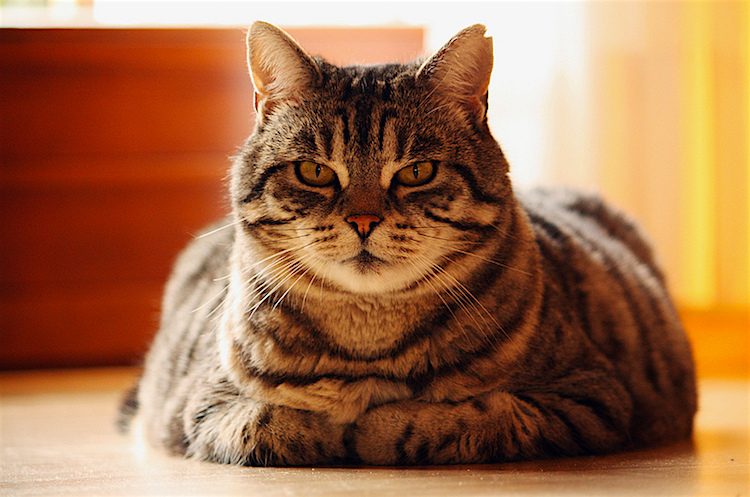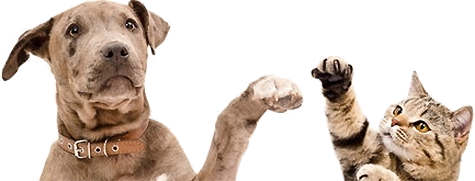
I brought Cheshire and Dervie in for their checkups the other day. The brothers are big boys. For the past year, I’ve been trying to get their weight down by putting less food out.
Alas, both boys had gained weight. Apparently, portion control doesn’t work for cats. Cheshire, our former runt, had morphed into a striped barrel with short legs, and we couldn’t figure out how it had happened.
My veterinarian could. Cheshire was a grazer, he said. But, what does that mean?
This article dives into some background on free feeding cats and cat grazing, and explores the common questions of “Is free feeding bad for cats?”
What is Free Feeding?
To talk about free feeding cats and some of its affects regarding your pet’s health, we first need to go over what it entails.
Free feeding is a feeding method where dry cat food is left out throughout the whole day to allow the cat to eat whenever they want. The food remains out and available for your cat to munch on as they please, dictating their own eating habits.
The Lowdown on Grazing: Is Grazing Bad for Cats?
For cats, grazing is basically nibbling at their food off and on all day. It’s not exactly normal to them.
“The types of animals that graze are herbivores: goats, cows, horses, sheep and so on,” remarks writer JaneA Kelley. “They graze because their bodies are built to chew, digest, regurgitate, chew again and digest again…. Cats, on the other hand, are carnivores. Their stomachs are not designed for grazing.”
Possible Pros of Free Feeding Cats
At first, free feeding — another term for grazing — seems like the best answer. If you work all day or have to be away for any length of time, there’s an ever-ready bowl of dry food available, and your feline will be fine until you get home. For busy pet parents, this method can be convenient and lower stress.
It also makes life a little easier in a multi-cat household. Most of my pet-sitting clients have more than 1 cat. Some of the cats get canned food, some of them don’t, but all have some kibble nearby. At one home, each of the 5 cats has their own bowl of dry food.
When Free Feeding Becomes a Problem
So, is free feeding bad for cats?
The issue with free feeding, explains Dr. Thomas Morganti, DVM, of the Avon Veterinary Clinic in Connecticut, is that every time your cat goes for that kibble, there’s an insulin spike. The pancreas can’t handle the long-term overload, and eventually you’re looking at a cat with diabetes.
Possible Cons of Free Feeding Cats
Dr. Debora Lichtenberg, VMD, has explained here at Petful that offering all-day dry food is especially problematic: “Cats conditioned to the never-ending dry buffet are at risk for developing obesity, urinary problems and kidney failure, to name just a few of the top feline health risks of a dry food diet. It would be like a human moving his recliner to a Las Vegas buffet.”
That said, it really doesn’t matter what you feed your buddy — it’s the frequent feeding, not the type of food, that’s could be a problem.
Overeating runs the risk of possibly leading to certain health issues for cats, such as obesity. Obesity in cats becomes a problem because it can have other health consequences for them. Health issues that could possibly arise include diabetes, arthritis, and heart problems.

Meal Feeding
Figuring out a meal schedule that works best for your cat’s individual needs is important. When in doubt, consulting with a vet can help you with crafting a good routine. If you’re looking to stop free feeding cats, then there are other options. Here is one tip on how to go from free feeding to scheduled cat meals.
Meal feeding is the solution, says the Cat Hospital of Chicago. “Start by picking up the food when you leave for the day,” the hospital advises, “and putting it down when you return. The cat(s) start to realize that the food will not always be available.”
Was YOUR Pet Food Recalled?
Check Now: Blue Buffalo • Science Diet • Purina • Wellness • 4health • Canine Carry Outs • Friskies • Taste of the Wild • See 200+ more brands…

With meal feeding, each cat receives “a measured portion of food, usually 2 or more times a day. He or she eats the food immediately in a meal fashion, as opposed to grazing on food all day.”
A Counter Story
In February 2014, UPI published an article that seemed to contradict all this. “Fat cats can slim by ‘grazing’ their kibble all day,” claimed the headline.
At the University of Illinois College of Agricultural, Consumer and Environmental Science (ACES), researcher Kelly Swanson and his assistants found that upping “the frequency of meals fed per day, as well as offering meals that contained added dietary water, promoted more physical activity among cats.”
The felines in the 4 study groups all received the same amount of food; the only variable was the number of meals. Activity apparently increased 2 hours before each meal. “If they know they are going to get fed, that’s when they are really active, if they can anticipate it,” Swanson commented.
The point is, the cats were getting meals. Grazing had nothing to do with it. So the headline turned out to be totally misleading.
This video from Jackson Galaxy helps explain the differences in feeding for cats:
Other Solutions
- Put your cat’s dry food in “a rolling puzzle ball so he has to work for his meals,” says Kelley. “But just don’t load up a huge bowl of kibble and go about your merry way.”
- Play with your cat. He’ll get a light workout, and you’ll have some quality bonding time.
- No “extreme” diets. Newsflash: They don’t work for anybody. In fact, they can “produce serious abnormalities that may jeopardize the cat’s life,” according to The Cornell Book of Cats.
I’m taking a moderate approach. The food bowls go down early in the morning and stay down for a few hours; they reappear in the late afternoon, then disappear at bedtime.
Cheshire’s still looking anxious, but I assure him it’s worth it.
Frequently Asked Questions (FAQ)
Should I Leave Dry Food Out for My Cat All Day?
By leaving dry food out for your cat all day, you are giving them the option of grazing, or ‘free feeding’. As mentioned, this can come with some drawbacks regarding your cat’s health. It’s also possible that the dry food could become stale if left out for too much time.
Should You Free Feed Kittens?
A kitten’s diet is important for their growth and development, and so establishing a feeding method that works for them is important. Free feeding is one option that some pet parents take, but some concerns do still apply, so it can be beneficial to discuss with a vet to determine the best feeding method for your kitten.
How Often Should I Feed My Cat?
This can vary depending on your cat’s individual health, age, activity level, and other factors that make them unique. In general, about two to three times a day can be sufficient for most adult cats, but of course, a vet can help you come up with a feeding plan that is particular to your individual cat’s needs.



